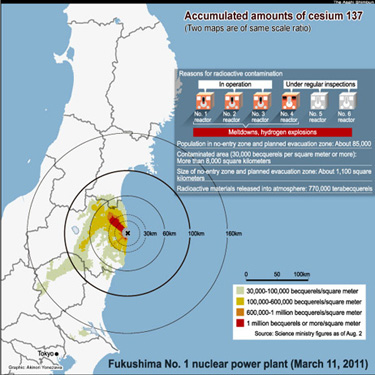Fukushima Cesium Contamination Widespread
But Less Than Chernobyl

Fukushima Power Plant
EMF Protection Devices
Magnetic Field Detector
September 13, 2011 |
By HIROSHI ISHIZUKA
An extensive area of more than 8,000 square kilometers
has accumulated cesium 137 levels of 30,000 becquerels per
square meter or more after the accident at the Fukushima No.
1 nuclear power plant, according to Asahi Shimbun estimates.
The affected area is one-18th of about 145,000 square
kilometers contaminated with cesium 137 levels of 37,000
becquerels per square meter or more following the 1986
Chernobyl accident in the former Soviet Union.
The contaminated area includes about 6,000 square
kilometers in Fukushima Prefecture, or nearly half of the
prefecture. Fukushima Prefecture, the third largest in
Japan, covers 13,782 square kilometers.
The government has not disclosed the size of the area
contaminated with cesium 137 released from the crippled
Fukushima No. 1 plant. Cesium 137 has a long half-life of
about 30 years.
The Asahi Shimbun calculated the size of the contaminated
area based on a distribution map of accumulated cesium 137
levels measured from aircraft, which was released by the
science ministry on Sept. 8.
The estimated size may increase in the future because the
distribution map will be subject to corrections and because
it currently covers only five prefectures.
The contaminated area includes about 1,370 square
kilometers in northern Tochigi Prefecture, about 380 square
kilometers in southern Miyagi Prefecture and about 260
square kilometers in Ibaraki Prefecture.
In the Chernobyl accident, a vapor explosion occurred at
the No. 4 reactor during an experiment, spewing radioactive
materials contained in fuel up thousands of meters into the
atmosphere, which spread over Europe and other areas in the
Northern Hemisphere.
The amount of radioactive materials released from the
Fukushima No. 1 plant was relatively limited because the
reactors were damaged but still sealed to some extent.
After the Chernobyl accident, cesium 137 levels of 37,000
becquerels per square meter or more were accumulated in an
area about 145,000 square kilometers, or equivalent to about
40 percent of Japan, according to the International Atomic
Energy Agency.
The science ministry's distribution map only shows the
area contaminated with 30,000 becquerels of cesium 137 or
more, not detailed breakdowns such as 37,000 becquerels.
The no-entry zone and the planned evacuation zone around
the Fukushima No. 1 plant total about 1,100 square
kilometers, affecting about 85,000 residents.
In the planned evacuation zone, the government has called
on residents to leave on the grounds that radiation levels
will exceed 20 millisieverts a year.
After the Chernobyl accident, a highly contaminated area
with cesium 137 levels exceeding 550,000 becquerels per
square meter was designated as a forced migration zone.
It stretched over about 10,300 square kilometers in the
current Belarus, Russia and Ukraine, and an estimated
400,000 residents evacuated, including those outside the
zone.
According to the science ministry's distribution map,
about 600 square kilometers around the Fukushima No. 1 plant
was contaminated with cesium 137 levels of 600,000
becquerels or more. The area is one-17th the forced
migration zone around the Chernobyl plant.
Radiation levels are still high in the area. Measurements
in six locations in the town of Namie, Fukushima Prefecture,
which are 24 to 31 kilometers from the Fukushima No. 1
plant, ranged between 4.5 and 32.6 microsieverts per hour on
Sept. 9.
The accidents at the Fukushima No. 1 plant and the
Chernobyl plant are both rated the worst level 7 on the
International Nuclear Event Scale because the quantities of
radioactive materials released exceeded several tens of
thousands of terabecquerels.
The amount of radioactive materials released into the
atmosphere from the No. 1 to 3 reactors at the Fukushima No.
1 plant is estimated to be 770,000 terabecquerels.
The amount is about one-seventh the 5.2 million
terabecquerels released into the atmosphere from the
Chernobyl plant over 10 days.
Of various radioactive materials, the amount of cesium
137 was 15,000 terabecquerels in the Fukushima accident,
about one-sixth the 85,000 terabecquerels in the Chernobyl
accident.
Cesium 137 levels of the atomic bomb dropped on Hiroshima
were far lower, at only 89 terabecquerels.
An official at the Nuclear and Industrial Safety Agency
said a nuclear plant accident is substantially different in
nature from an atomic bomb.
Radiation accounts for only 15 percent of the energy of
an atomic bomb, with the remaining 85 percent resulting in
the blast and heated air.
After the
Fukushima accident, people will be exposed to low levels of
radiation over a long term, whereas atomic bomb victims were
immediately exposed to high levels of radiation and suffered
acute symptoms, such as diarrhea, fever and hair loss.
http://www.emfnews.org/store
|